Conflict is a natural part of working closely in small teams. Handle it constructively, and you turn conflict into a catalyst for better business outcomes.
Effective conflict management defuses tension and turns challenges into opportunities to improve teamwork, increase employee engagement and build a more innovative, collaborative workplace.
In this article, you’ll learn five conflict management strategies you can implement in the workplace, along with example scenarios. You’ll also discover how a collaborative CRM like Pipedrive helps reduce disputes and solve them faster when they arise.
What is conflict management?
Conflict management involves identifying and resolving disagreements between two or more employees.
It’s a part of personnel management that uses emotional intelligence, active listening, problem-solving and mediation to minimize negative incidents. It also promotes positive outcomes, such as stronger levels of trust and better working relationships.
There are many sources of conflict in small businesses, including:
Unclear roles – a chief sales officer and customer success manager both believe they own the customer onboarding process, leading to tension and duplicated work
Communication gaps – a remote development team blames a missed project deadline on the design team’s inability to answer emails promptly
Creative differences – two marketing managers have vastly different ways of creating campaigns, leading to intra-department tension and missed deadlines
Conflict resolution strategies resolve issues before they escalate and impact morale.
Imagine a mid-sized B2B SaaS company where project handovers consistently cause issues between designers and developers, delaying product launches.
A director holds a mediation session to solve the conflict. They actively listen to each team’s grievances. Then, they make them aware of the conflict’s impact on the business and help them create a collaborative handover management process that delivers clarity and accountability.
By encouraging teams to work together to solve the issue, the director improves collaboration and productivity and ensures products launch on time.
Now you’ve got an idea of what conflict management looks like, you’ll want to know why it’s so important when managing small businesses.
Download your guide to managing teams and scaling sales
Why conflict management matters in SMBs
Conflict management is critical in small teams with fewer resources, where a single personality clash can derail entire projects. While intimate settings can heighten tensions and spotlight poor working relationships, they also make it easier to address the problem.
Here are the benefits your small business can expect when you apply effective conflict management strategies.
Lower costs and higher productivity
Conflict management stops workplace disputes from becoming enormous productivity drains, saving businesses millions.
Research finds that conflict costs US companies $3,216.63 per employee per year in productivity. That’s over $1.6m annually for a company with 500 employees..
Quick resolutions let people focus on their work rather than managing tension or ignoring employees. Work gets completed rather than delayed.
Effective conflict management also frees up managers’ time dealing with disputes, which averages over four hours a week, according to the Myers-Briggs Company.
Happier employees and higher retention rates
Conflict management stops disputes from becoming a leading driver of turnover by increasing employee engagement and boosting morale.
Studies show that those who rate their work environment as “uncivil” are three times more likely to be unsatisfied with their job and twice as likely to leave within a year. Conflict also causes 53% of people to feel workplace stress and 77% to disengage.
Solving issues openly and fairly gives your employees confidence that you will address their grievances. It empowers them, allowing them to contribute ideas without fear of backlash.
A more innovative and collaborative workplace
While disputes can damage relationships if left unmanaged, constructive conflict management fosters trust, cooperation and innovation.
The Myers-Briggs Company finds that the most frequently mentioned positive benefit of workplace conflict was the opportunity to increase collaboration and cooperation.
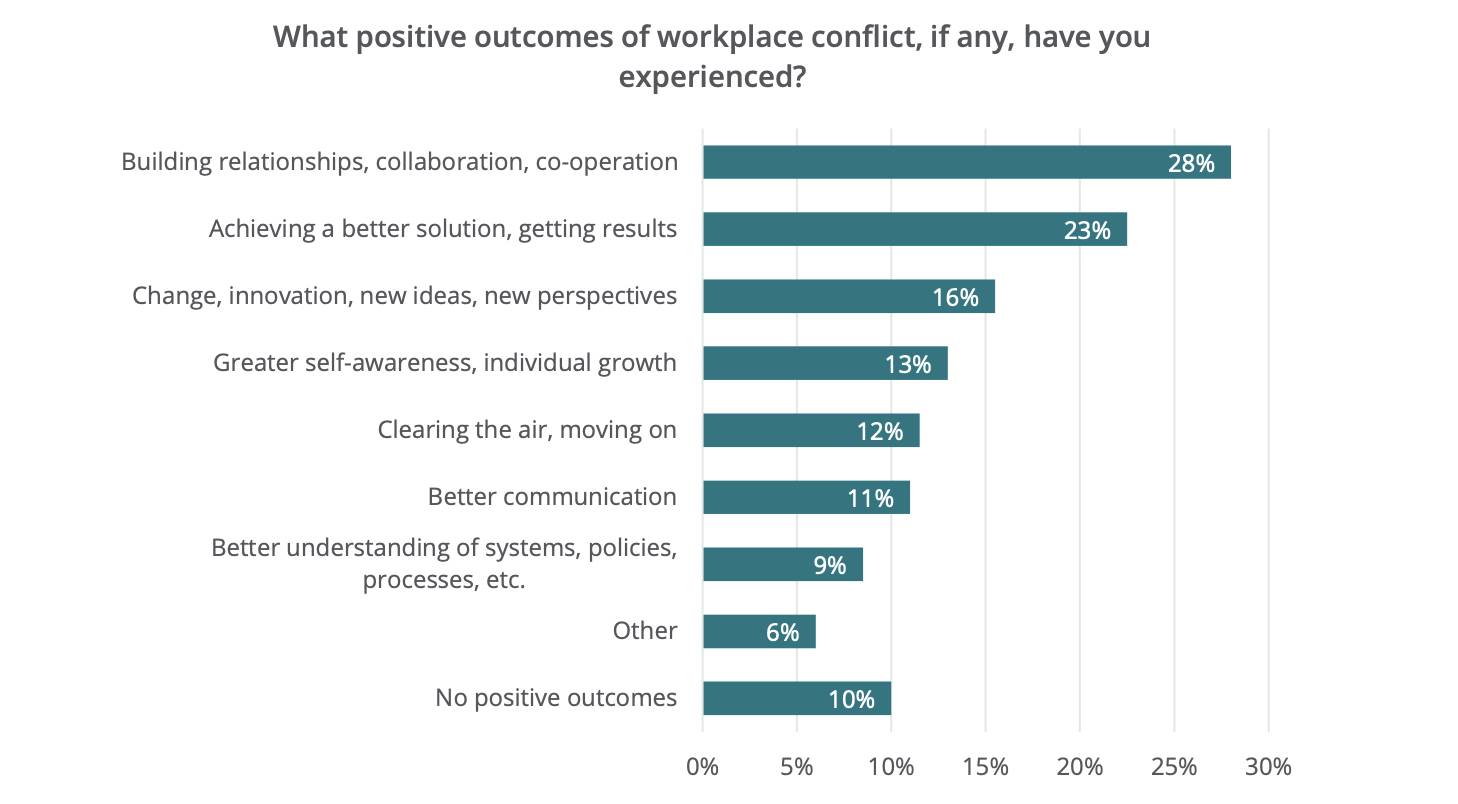
Disagreements can even lead to innovative approaches, writes Amy Gallo, a cohost of the Women at Work podcast and the author of Getting Along: How to Work with Anyone (Even Difficult People):
Conflict resolution skills and open communication prevent costly disruptions, transforming tensions into growth opportunities.
Next, discover how to improve your conflict resolution decision-making by knowing which conflict management styles yield the best results.
What are the different conflict management styles?
The Thomas-Kilmann Conflict Model identifies five distinct conflict modes, each with different levels of assertiveness and cooperativeness.
In assertive styles, users address their own concerns. In cooperative styles, participants satisfy the concerns of others.
You can see the different types of conflict management styles explained in the following table:
Collaborating |
|
Competing |
|
Avoiding |
|
Accommodating |
|
Compromising |
|
Another way to compare the styles is to use the level of assertiveness and cooperativeness to place them on the following matrix:
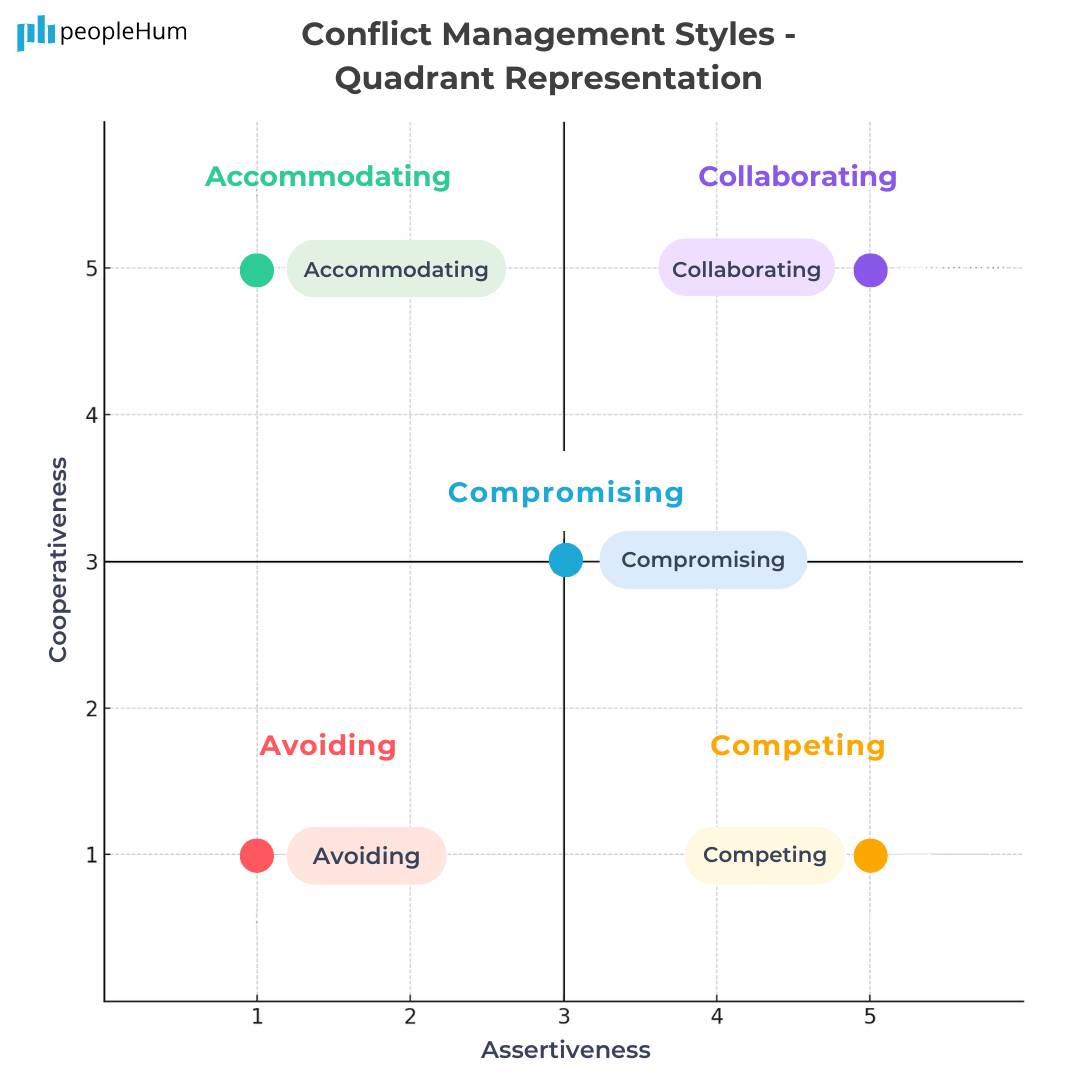
5 examples of workplace conflicts and how to manage them
Workplace conflicts are commonplace, with CIPD research suggesting that a quarter of employees face them every year. Disputes occur for various reasons, ranging from simple misunderstandings to significant differences in style and approach.
Handling conflict quickly and effectively requires a tailored approach that considers the issue and the employees involved.
To guide you, here are five common examples of conflict management and suggestions for resolving them.
1. Cultural misunderstandings
Cultural misunderstandings happen when employees from different backgrounds misinterpret a colleague’s language, behavior or communication style.
Conflicts aren’t malicious at first, but they can generate resentment, create rifts, cause good employees to leave and even lead to legal action.
Example: An employee from one cultural background makes an off-hand comment unrelated to work during a sales meeting, offending another team member. The colleague affected doesn’t react immediately. Instead, they take the matter to human resources, who must decide how to respond.
How to resolve the conflict:
The HR manager decides that a policy of mediation, open communication and listening is fundamental to solving the matter. They arrange the following:
A private meeting where one colleague explains why they found the comment so offensive
Establishing communication guidelines that encourage employees to discuss their perspectives on culturally sensitive topics
Mandatory diversity training that teaches employees how to navigate cross-cultural issues in the workplace
A successful meeting involves the offending employee apologising to their colleague, eliminating the need for disciplinary action. An honest conversation and ongoing training help both workers collaborate better moving forward.
2. Work-style clashes
Work style clashes are a type of interpersonal conflict that occurs when employees have differing approaches to completing tasks. They can erupt into arguments, lower employee morale and hinder productivity.
They’re the most common cause of conflict in the workplace, according to the above-mentioned CIPD study.
What issues did the most serious incident of conflict focus on?
Almost half (46%) of survey respondents said classes resulted from personality differences. The second most common cause was incompetence, responsible for 36% of conflicts.
Example: You’re a go-getting project manager who starts tasks immediately. Your colleague is more laid back, preferring last-minute bursts of effort. Things come to a head when their working style delays projects and impacts your team’s performance.
How to resolve the conflict:
Noticing the delays, the business owner steps in to mediate the issue and find a compromise between the two working styles that are unlikely to change significantly. Mediation steps include:
Facilitating a conflict resolution session where both parties share their working preferences and concerns
Building a hybrid workflow that strikes a balance between both working styles
Changing “due dates” to “start dates” to encourage employees to work on projects sooner
The business owner acknowledges that neither employee is willing to change their working style drastically. They find a middle ground that gives both some leeway while ensuring work gets done on time.
3. Power struggles
Power struggles happen when unclear roles or overlapping responsibilities mean senior leaders compete to own the same task. This lack of structure results in duplicated or unfinished work because each team thinks the other is responsible.
Ownership-related conflicts are prevalent in small businesses with limited teams and flat hierarchies.
Example: Imagine a small healthcare software provider where the head of sales and the customer success manager each think they should be responsible for onboarding customers. Neither wishes to cede control, forcing employees in both teams to complete onboarding work twice. The approach leaves customers in limbo, unable to start using the product and unsure who can help.
How to resolve the conflict:
Seeing how the power struggle is destroying the customer experience, the CEO makes intervening a priority:
Holding individual meetings helps the CEO to understand each leader’s perspective
Chairing a mediation session lets both parties air their grievances with the existing process and work together toward a solution
Creating a shared vision and strategy enables leaders to see that they both care about giving the customer a great experience
Building a collaborative workflow offers a compromise where both teams can have input over the process
Senior leaders rarely back down from a power struggle, so a win-win solution requires compromise.
By demonstrating that the heads of sales and customer success ultimately share a common goal, the CEO effectively turns the conflict into an opportunity to establish new workflows that improve customer experiences.
4. Performance-related issues
Underperforming colleagues commonly cause workplace conflict, as coworkers take on more work to complete tasks.
Whether due to laziness or unclear instructions, managers must resolve performance issues promptly before high-performing employees seek new roles.
Example: A sales team requires sales development reps (SDRs) to qualify leads from marketing. Most employees work diligently, contacting prospects, clarifying their needs and passing them on to sales executives. One SDR isn’t as productive as their colleagues, so the team often misses out on performance-related bonuses.
How to resolve the conflict:
When high-performing SDRs complain to sales managers about the state of affairs, it’s up to them to have an honest conversation about the rep’s performance. The sales manager:
Uses CRM reports to compare the under-performing rep’s activity with the rest of the team
Sits down in private with the rep to show the disparity and uncover the reason behind it
Realizes the rep’s underperformance wasn’t due to laziness but a lack of training
Arranges for the rep to redo the company’s onboarding process and have one-on-one sales coaching
Performance-related issues don’t have to escalate into an argument or disciplinary action. Difficult conversations can uncover the root cause, improve productivity and boost team morale without having to let a team member go.
5. Resistance to change
Some conflict situations occur when employees are unable or unwilling to adopt new policies. They can cause resentment among team members who go out of their way to learn new practices, and lead to incomplete work due to poor communication.
Example: A web design agency mandates Slack for all team communication. A remote developer refuses to use the platform, meaning they’re uncontactable for large chunks of the day. They miss important project updates and deadlines change as a result. The rest of the team is unhappy about one developer holding them back.
How to resolve the conflict:
The development lead acknowledges their team’s concerns and speaks to the developer in private to resolve the situation. They:
Ask why the developer doesn’t want to use Slack, validating the person’s feelings rather than dismissing them
Communicates the reasons for the change clearly and honestly, showing them how their work life will improve by using the tool
Provide training and support to get up to speed with Slack
Offer to meet regularly with them to see how they’re getting on and whether they can improve workflows further
By addressing the developer’s resistance with empathy and involving them in the change, the manager reduces tension, encourages adoption and builds a more collaborative remote team.
How Pipedrive supports conflict management
Pipedrive is a sales-focused customer relationship management (CRM) tool that small business owners can also use to mitigate workplace conflict.
The platform can help SMBs overcome some root causes of power struggles, performance problems and work-style clashes through effective collaboration, communication and accountability practices.
Here’s how to manage conflict in the workplace using Pipedrive’s core features.
Centralize sales and customer data to increase visibility
A CRM system acts as a company’s single source of truth, centralizing customer data, contact information and interaction history. The software ensures everyone in your business works from the same set of accurate information, reducing silos and increasing transparency.
Features like activity tracking and communication logs minimize misunderstandings and reduce disputes about responsibilities.
For example, employees can use Pipedrive’s contacts timeline feature to see who contacted a lead and when:
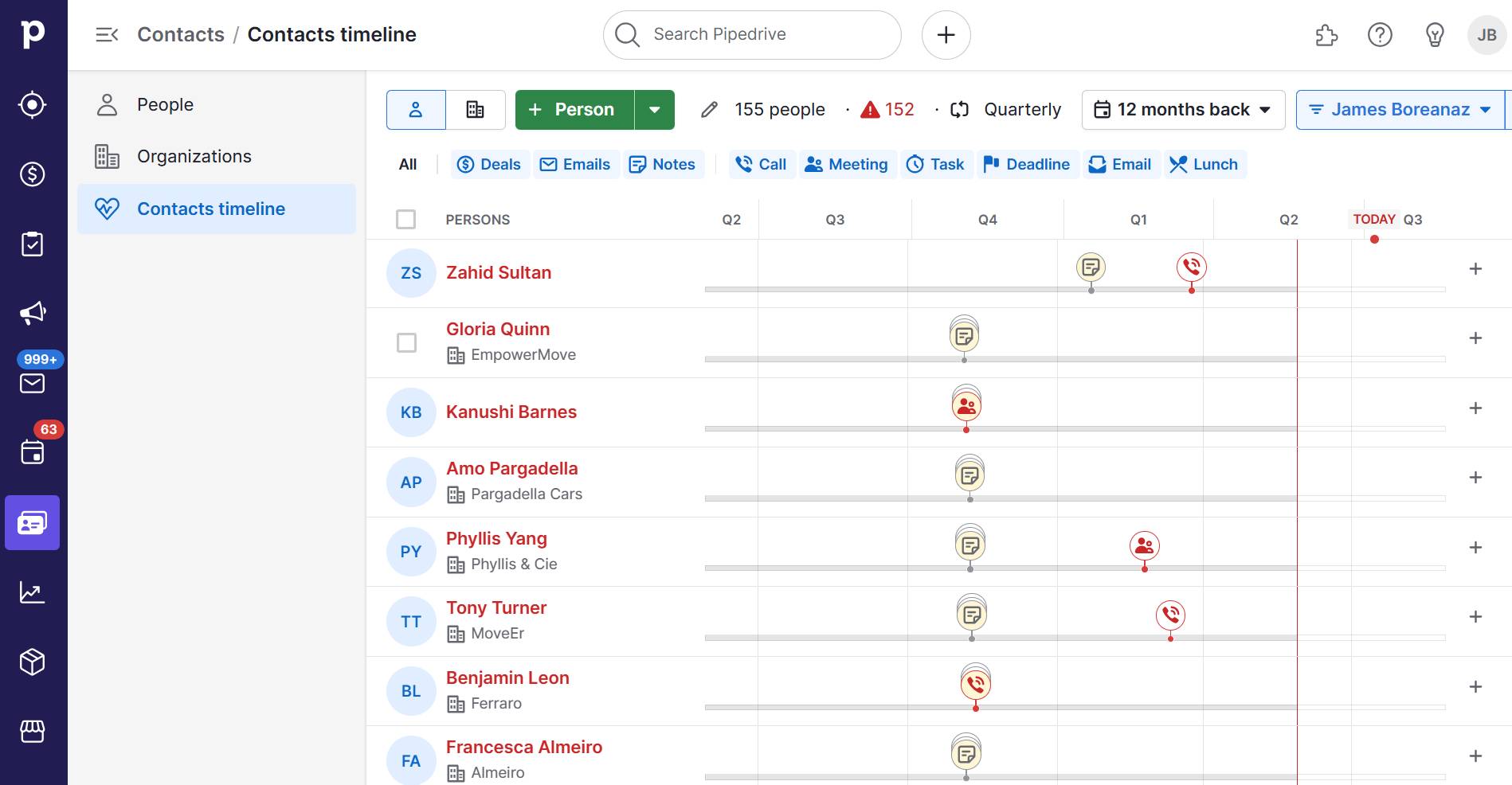
If performance or work-related issues crop up, managers have the data to address and fix them quickly and effectively.
Use project management features to set deadlines and assign responsibility
Projects by Pipedrive is a project management tool that lets you map out projects, delegate tasks, set deadlines and track progress.
Here’s what a typical dashboard looks like in Projects:
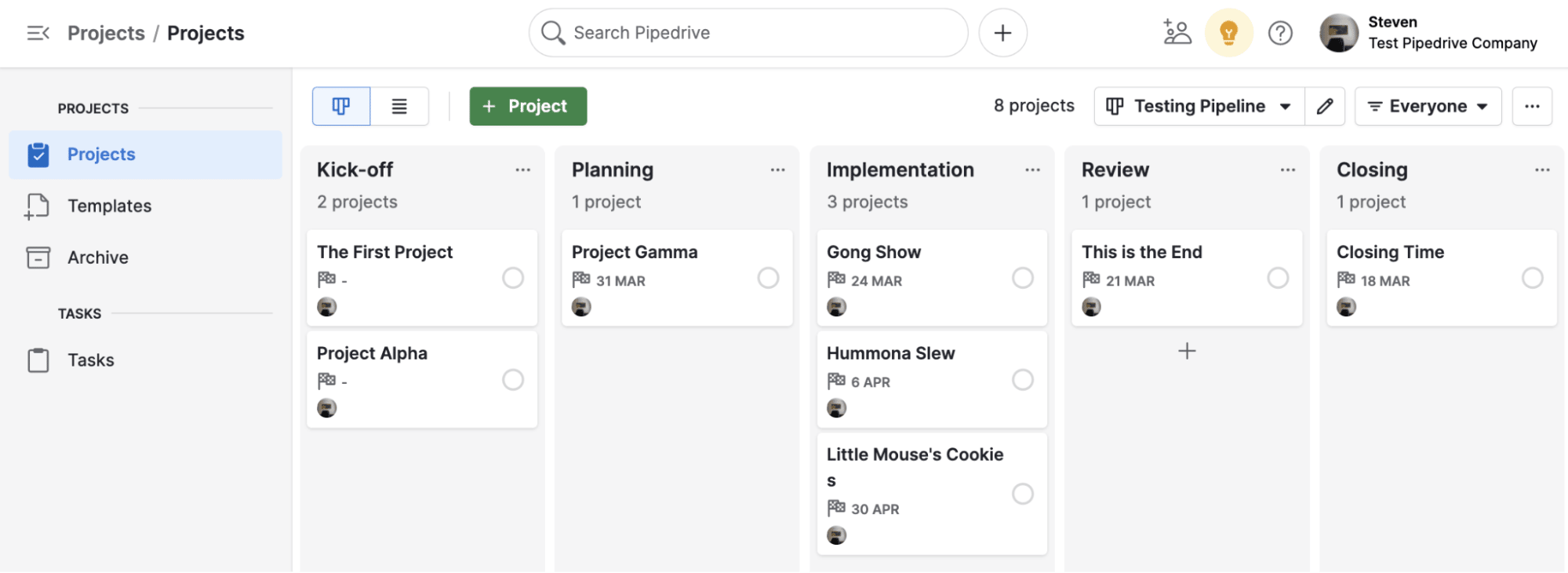
Use the following features to reduce conflicts within and across departments:
Set task ownership and deadlines – assign tasks and subtasks to specific team members with due dates, ensuring everyone knows their responsibilities and timelines
Centralized communication – add notes, share files and mention team members directly within specific projects to centralize information and minimize communication issues
Progress tracking – create customizable dashboards to track project statuses and bottlenecks, allowing you to resolve conflicts before they escalate
Centralizing your small business’s tasks in Projects reduces power struggles and other conflicts that stem from project ownership or communication issues.
Run reports to solve performance-related conflicts
Use Pipedrive’s Insights feature to address conflicts about performance by tracking real-time sales activity.
Insights lets you break down rep performance in the following ways:
Activity reports – the number of sales activities reps complete
Email reports – the performance of emails that reps send
Lead conversion – how well reps convert leads into deals
You can monitor everything through customizable dashboards like the one below:
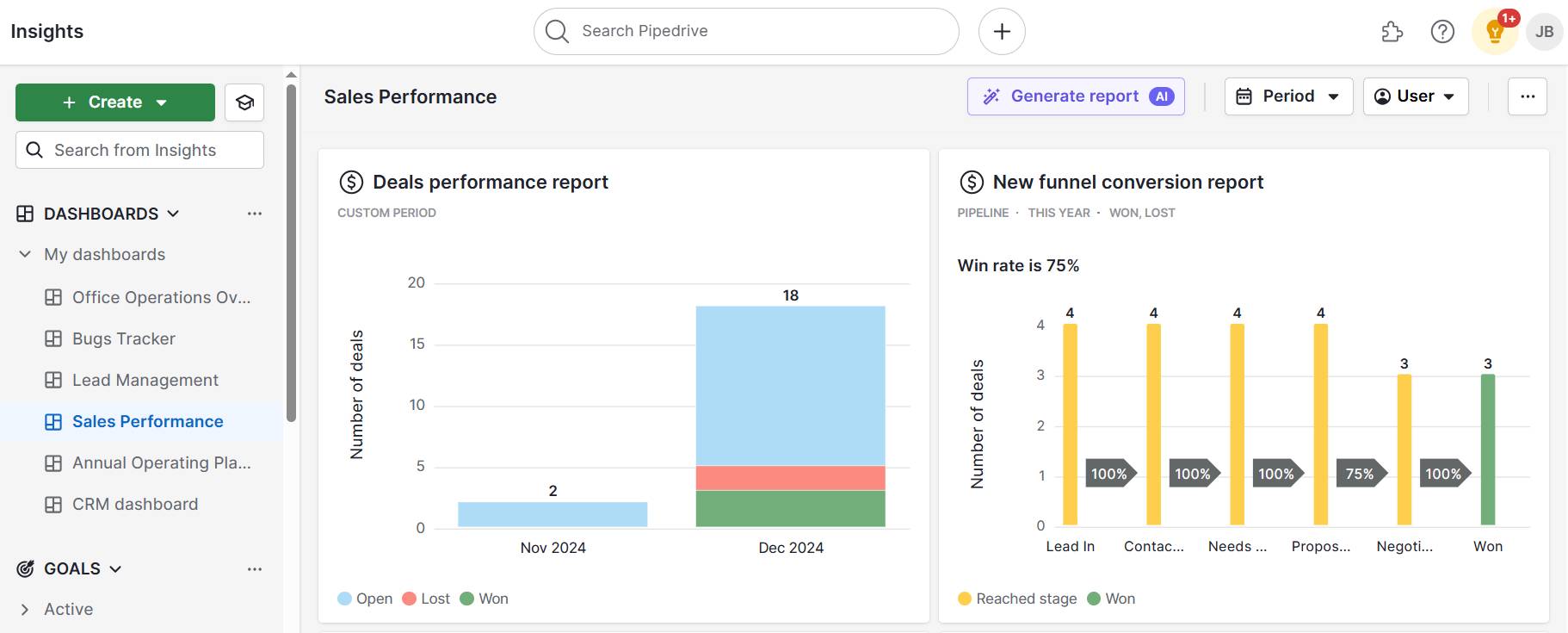
Regularly reviewing reports helps sales managers identify underperforming salespeople before their poor performance leads to team unrest.
Final thoughts
Effective conflict management turns disputes into growth opportunities. Increasing collaboration in your small business boosts employee satisfaction and cultivates a positive, results-driven workplace.
A CRM like Pipedrive enhances transparency and communication to fix your conflicts fast. It prevents clashes over responsibilities and priorities, centralizes work efforts and stops tasks falling through the gaps.
Discover how Pipedrive’s collaborative features can improve your team’s collaboration and reduce workplace conflicts with a free 14-day trial.






